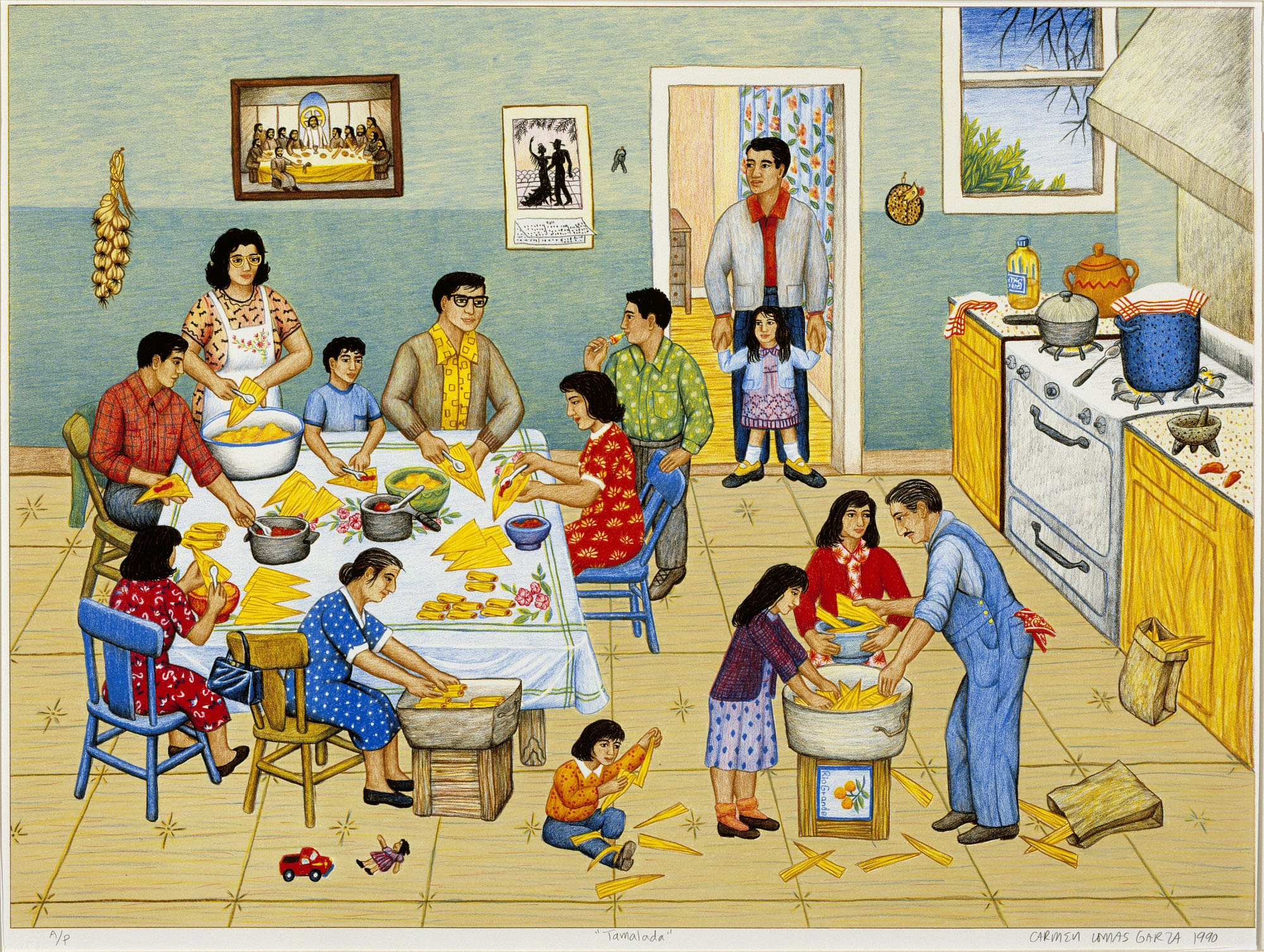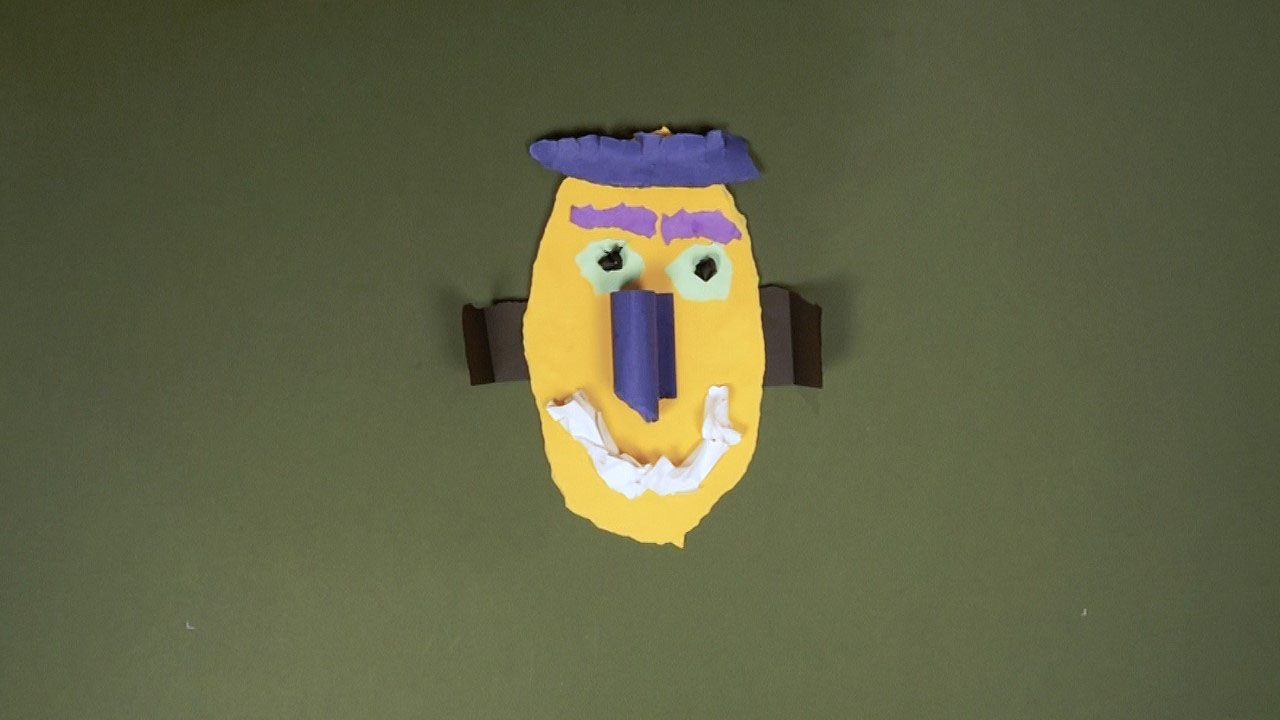Overview
Students will reflect on their art making using close-looking, speaking, writing, and/or sketchbook prompts.
Grade Level
K-2
Media
Drawing and Collage
Theme/ Big Idea
Everything we see in the world around us is made up of lines and shapes.
Essential Question
How can I look closely to find lines and shapes, and use them to make something new?
Materials and Tools
- Pencil
- Sketchbook or one to two pieces of paper
- Imaginary character collage from Lesson 9
Activities
Note: The following activities are written with sample language you may use with your students. Following the art-making lesson, you may choose as many reflection activities as desired for students to work on in class or independently.
Step 1: Introduction (2 minutes)/ Close Looking: Carmen Lomas Garza (10-15 minutes)
Hello, artists! In this lesson, we are going to reflect on our imaginary character collage and think about who our character might be.
Note to Teachers: Before teaching with a work of art, spend some time closely looking at it on your own. Familiarizing yourself with the artwork will prepare you to guide the close-looking activity.
If your students are new to looking at art together, you can introduce the activity to students in the following way:
Today we are going to spend some time looking at and discussing a work of art together. When we look at art, there are no right or wrong answers. I’m going to ask you to look closely, share your ideas about what you see, and listen respectfully to each other’s ideas. Everyone’s ideas are important. We all see things differently, and when we look at art, we can learn to see through each other’s eyes.

Let’s look closely at Tamalada by Carmen Lomas Garza again. Take a moment to look on your own.
Give students a silent minute to look.
- What do you think is happening in this painting?
Choose a person from the painting and look closely.
- What are they doing?
- What do you think they might be saying?
Introduce your imaginary person to someone in the painting.
Have your imaginary person ask someone in the painting a question.
Facilitate having students use their collage character to talk to someone in the painting.
Step 2: Close Looking Activity/Sharing Student Work (10 minutes)
Take a moment to look at your imaginary-character collage.
- What is your imaginary character’s name?
- What do they like to do for fun?
Have your imaginary character introduce themself to a partner (in the classroom),
OR have your imaginary person introduce themself to a family member (at home).
Model how students can turn-and-talk to answer the questions above with a partner.
Step 3: Writing Activity (10-15 minutes)
Now we are going to write about our imaginary character. Start by looking at your imaginary character collage.
- How can you describe this character?
- What is your character’s name?
- What do they like to do for fun?
- What do they like to eat? How do they feel, and why?

Based on your students’ writing skills, choose from the options below:
Option 1: Write three sentences to answer the questions above about your character.
Option 2: Use the sentence frames below to write a sentence about your character.
My imaginary person’s name is ___________.
My imaginary person likes to ____________.
My imaginary person likes to eat ____________.
My imaginary person feels ______________.
Step 4: Sketchbook Activity (10-15 minutes)
Take a moment to look at your imaginary-character collage. Draw a picture of your character collage. Now, include details or a background to show something you would like people to know about your character.
Vocabulary
Collage
Character
Background
Details
Resources
Carmen Lomas Garza, Tamalada (Making Tamales). 1990, Smithsonian American Art Museum: https://americanart.si.edu/artwork/tamalada-35507
Carmen Lomas Garza’s Website: http://carmenlomasgarza.com/
Adaptation of Carmen Lomas Garza’s Tamalada as an interactive environment at the Children’s Museum in Austin, TX. https://www.youtube.com/watch?v=4ZyAJ04ScbM
Extensions
Using Sound
Come up with a voice for your imaginary person that is different from your own.
Greet someone using this new voice.
Sketchbook Prompt
- How is your imaginary person feeling?
- Can you draw your imaginary person with a different emotion?
